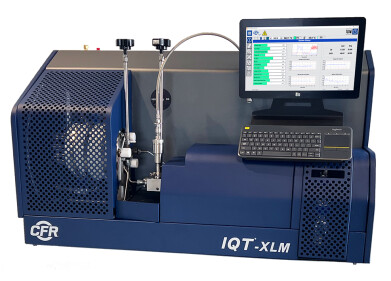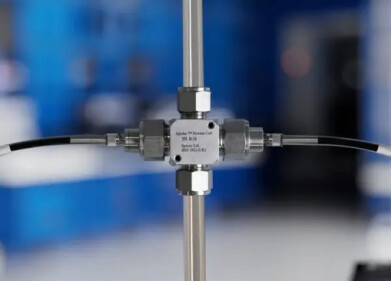Analytical Instrumentation
Improved Reliability and Operability for Reduced OPEX and Enhanced Plant Safety with New Tunable Diode Laser Spectrometer
Apr 24 2015
Yokogawa Electric Corporation (the Netherlands) announces the release of the TDLS8000 tunable diode laser spectrometer on May 7. This new product can quickly make in-situ measurements of gas concentrations in combustion and heating processes that are employed in the oil, petrochemical, electric power, iron and steel, and other industries.
As the successor to the TDLS200 laser gas analyser, the TDLS8000 offers improved reliability and operability. With this new product, Yokogawa aims to capture a greater share of the gas analyser market by offering a solution that will make it possible to improve plant efficiency and safety.
Companies are always looking for ways to optimise processes by saving energy, reducing CO2 emissions, and improving safety and one way to do this is by optimising the air-fuel ratio in the combustion process. To accomplish this, sensors are needed that can continuously monitor the concentration of O2 and CO+CH4 in the radiant section of fired heaters.
The TDLS200 laser gas analyser is capable of quickly performing in-situ measurements of the concentration of near-infrared absorbing gases such as O2, CO, CO2, and NH3. Since the TDLS200 was released in 2008, its high accuracy and precision have earned it a good reputation in the marketplace, and it has gone on to become one of the best-selling instruments of its type in the global market (based on a Yokogawa market survey).
The TDLS8000 is being introduced as the successor to the TDLS200 to satisfy the need for improved operability and to allow for greater adaptability in difficult applications.
The TDLS8000's laser module includes a newly developed reference cell board that improves the reliability of absorption peak detection, which is an important step in the spectral area method. In addition, the receiving unit employs a new auto gain function that can automatically optimise detection sensitivity depending on the measurement object. By increasing the signal-to-noise ratio (S/N ratio), this improves the reliability of measurements taken in coal combustion and other processes where there is high particulate loading. Designed to meet the requirements for SIL2 certification (certification pending) defined by the International Electrotechnical Commission (IEC), the TDLS8000 will play a key support role in ensuring the safe operation of plants.
Improved operability and maintenance efficiency The TDLS8000 comes with a large 7.5-inch LCD touch screen that can display a greater variety of data. The touch screen replaces the push button interface used with preceding models, making the setting of parameters easier and more intuitive. The light source module containing the laser diode is fully sealed and damage resistant. To facilitate troubleshooting and reduce downtime, this module is able to store up to 50 days' worth of raw data that can be accessed anywhere in the world by, for example, a Yokogawa response centre.
The redesigned TDLS8000 is just three-quarters the size and weight of the preceding model, allowing it to be installed in a greater variety of locations.
The TDLS8000 is expected to be certified to the IECEx, ATEX (Europe), FM (U.S.), cFM (Canada), and TIIS (Japan) explosion-proof standards. It will be suitable for installation in hazardous areas that require the use of an explosion-proof enclosure.
Major target markets include industries such as oil and gas, petrochemicals, chemicals, electric power, iron and steel, and ceramics
Applications include measurement of O2 concentration in fired heaters for improved safety and lifecycle management; measurement of CO concentration during combustion process; measurement of amount of moisture in hydrocarbons and corrosive gases and measurement of ammonia concentration for leak detection during DeNox process.
These instruments make use of tunable diode laser spectroscopy (TDLS) to measure the gas concentration. To determine the gas concentration, a receiving unit detects how much energy is absorbed as a laser beam is transmitted through a gas. With this technique, there is no need for a sampling device: the analyser can be installed directly on a gas duct and make measurements quickly, in real time. Yokogawa's analysers use a unique spectrum area method whereby the gas concentration is calculated based on the area in an absorption-distribution chart, and thus can stably measure the concentration of a specific gas in the presence of other gases or dust and under conditions where the temperature and/or pressure is fluctuating.
Digital Edition
PIN 25.5 Oct/Nov 2024
November 2024
Analytical Instrumentation - Picturing Viscosity – How Can a Viscometer or a Rheometer Benefit You? - Sustainable Grease Formulations: Evaluating Key Performance Parameters and Testing Method...
View all digital editions
Events
Dec 03 2024 Dusseldorf, Germany
Dec 08 2024 Anaheim, CA, USA
Turkey & Black Sea Oil and Gas
Dec 11 2024 Istanbul, Turkey
Dec 19 2024 Aurangabad, India
Jan 20 2025 San Diego, CA, USA



















